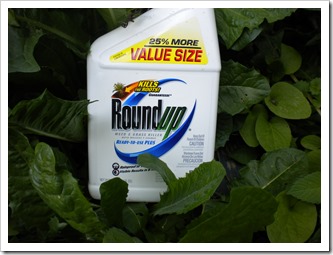Roundup is more toxic than declared proves new Séralini study
 In new research published in the highly ranked scientific journal Toxicology, Robin Mesnage, Benoît Bernay and Professor Gilles-Eric Séralini, from the University of Caen, France, have proven (from a study of nine Roundup-like herbicides) that the most toxic compound is not glyphosate, which is the substance the most assessed by regulatory authorities, but a compound that is not always listed on the label, called POE-15.
In new research published in the highly ranked scientific journal Toxicology, Robin Mesnage, Benoît Bernay and Professor Gilles-Eric Séralini, from the University of Caen, France, have proven (from a study of nine Roundup-like herbicides) that the most toxic compound is not glyphosate, which is the substance the most assessed by regulatory authorities, but a compound that is not always listed on the label, called POE-15.
Modern methods were applied at the cellular level (on three human cell lines), and mass spectrometry (studies on the nature of molecules). This allowed the researchers to identify and analyse the effects of these compounds.
Context: Glyphosate is supposed to be the “active ingredient” of Roundup, the most widely used herbicide in the world, and it is present in a large group of Roundup-like herbicides. It has been safety tested on mammals for the purposes of regulatory risk assessment. But the commercial formulations of these pesticides as they are sold and used contain added ingredients (adjuvants). These are often classified confidential and described as “inerts”. However, they help to stabilize the chemical compound glyphosate and help it to penetrate plants, in the manner of corrosive detergents. The formulated herbicides (including Roundup) can affect all living cells, especially human cells. This danger is overlooked because glyphosate and Roundup are treated as the same by industry and regulators on long-term studies. The supposed non-toxicity of glyphosate serves as a basis for the commercial release of Roundup. The health and environmental agencies and pesticide companies assess the long-term effects on mammals of glyphosate alone, and not the full formulation. The details of this regulatory assessment are jealously kept confidential by companies like Monsanto and health and environmental agencies.
Conclusion and consequences: This study demonstrates that all the glyphosate-based herbicides tested are more toxic than glyphosate alone, and explains why. Thus their regulatory assessments and the maximum residue levels authorized in the environment, food, and feed, are erroneous. A drink (such as tap water contaminated by Roundup residues) or a food made with a Roundup tolerant GMO (like a transgenic soya or corn) were already demonstrated as toxic in the recent rat feeding study (2) from Prof. Séralini team. The researchers have also published responses to critics of the study (3). This new research explains and confirms the scientific results of the rat feeding study.
Overall, it is a great matter of concern for public health. First, all authorizations of Roundup-type herbicides have to be questioned urgently. Second, the regulatory assessment rules have to be fully revised. They should be analyzed in a transparent and contradictory manner by the scientific community. Agencies that give opinions to government authorities, in common with the pesticide companies generally conclude safety. The agencies’ opinions are wrong because they are made on the basis of lax assessments and much of the industry data is kept confidential, meaning that a full and transparent assessment cannot be carried out. These assessments are therefore neither neutral nor independent. They should as a first step make public on the Internet all the data that underpin the commercial release and positive opinions on the use of Roundup and similar products. The industry toxicological data must be legally made public.
Adjuvants of the POE-15 family (polyethoxylated tallowamine) have now been revealed as actively toxic to human cells, and must be regulated as such. The complete formulations must be tested in long-term toxicity studies and the results taken into account in regulatory assessments. The regulatory authorisation process for pesticides released into the environment and sold in stores must urgently be revised. Moreover, since the toxic confidential adjuvants are in general use in pesticide formulations, we fear according to these discoveries that the toxicity of all pesticides has been very significantly underestimated.
This study was conducted in the University of Caen with the structural support of CRIIGEN in the European Network of Scientists for Social and Environmental Responsibility (ENSSER www.ensser.org).
…Republished from a CRIIGEN press release dated February 21, 2013…
For more information contact: criigen@unicaen.fr; phone +33 (0)231565684 (France).
——————————
Notes :
(1) Mesnage R., Bernay B., Séralini G-E. (2013, in press). Ethoxylated adjuvants of glyphosate-based herbicides are active principles of human cell toxicity. Toxicology http://dx.doi.org/10.1016/j.tox.2012.09.006
(2) Séralini G. E., et al. (2012). Long term toxicity of a Roundup herbicide and a Roundup-tolerant genetically modified maize. Food and Chemical Toxicology 50 (11): 4221-4231.
(3) Séralini G. E., et al. (2013). Answers to critics: Why there is a long term toxicity due to NK603 Roundup-tolerant genetically modified maize and to a Roundup herbicide. Food and Chemical Toxicology

![Peanut butter helps diagnose Alzheimer’s disease [RESEARCH] Peanut butter helps diagnose Alzheimer’s disease [RESEARCH]](https://www.thewellnessbee.com/wp-content/uploads/2014/01/PeanutButter_800w-300x300.jpg)
